Have you ever thought about how Anthuriums could transform your living space? Their ability to thrive in various conditions makes them a perfect choice for both novice and experienced plant lovers.
This guide dives into the world of Anthuriums, covering everything from their origins in the lush rainforests of Central and South America to the specifics of keeping them healthy and blooming. I’ll explore the diverse species, the ideal growing conditions, and how to care for these stunning plants to ensure they continue to bring joy to your home.
Ready to add a splash of color and a breath of fresh air to your home with Anthuriums? Let’s unlock the secrets to their care and learn how to make the most of these popular houseplants.
6 Key Takeaways on Anthuriums
- Anthuriums are beautiful, easy-to-care-for tropical plants that bring a splash of color to any space with their bright flowers.
- There are over 1,000 types of Anthuriums, but some favorites are the Queen Anthurium, King Anthurium, and Flamingo Flower. Each type has its own special look.
- Anthuriums love warmth and do best in temperatures from 60°F to 90°F. They like bright, indirect light and lots of humidity. For the soil, a mix that drains well is perfect. Water them regularly, but make sure there’s no standing water to keep their roots healthy.
- To help them bloom more, use a fertilizer with a lot of phosphorus. They also need some occasional pruning and repotting when they outgrow their pot.
- You can grow new Anthuriums from stem cuttings, dividing the roots, or seeds. Each way has its own needs and care tips.
- Anthuriums are toxic if eaten because they have calcium oxalate crystals. These can irritate both people and pets, so it’s best to keep these plants out of reach.
Anthurium Plant Overview
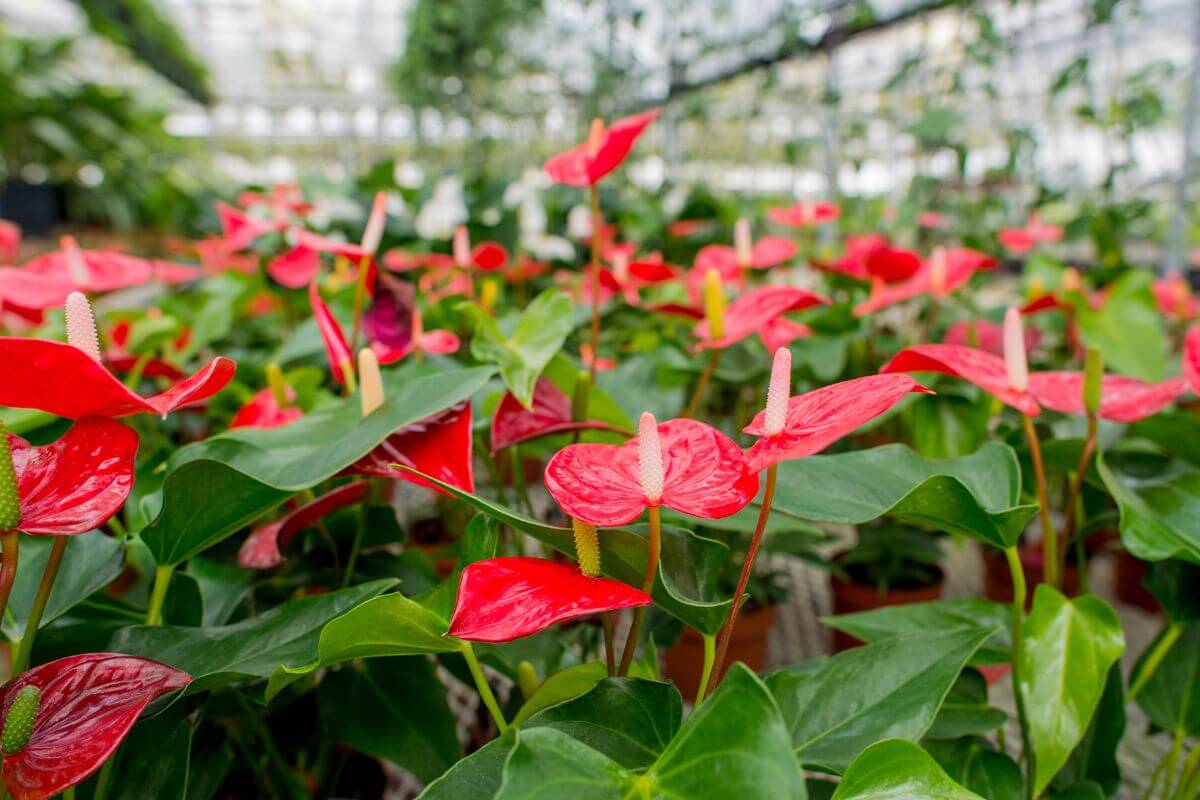
Anthuriums, often called Flamingo Flowers or Painter’s Palettes, are a treat for the eyes with their bright, flamingo-like bracts. Did you know there are about 1,000 types of these plants? They make up one of the biggest groups in the Araceae family and are cousins to the philodendrons.
- Read more: How to Grow Philodendrons
These plants come from the warm, wet areas of Central America, northern South America, and the Caribbean. They love the dampness of rainforests.
The flowers have a unique look with a spadix in the middle and a colorful spathe around it. You can find them in red, pink, white, or purple. Plus, their heart-shaped, shiny green leaves are a sight to behold, and they can grow up to 2 feet tall.
Anthuriums are usually slow to moderate growers. You’ll see new leaves and flowers mostly in spring and summer. Many of them don’t grow in soil but on other plants. This way, they can reach for more light and moisture.
People love Anthuriums as houseplants because of their eye-catching look and blooms that last a long time. They’re also a favorite in flower arrangements. In some cultures, giving an Anthurium is a sign of hospitality. It’s a lovely gift for special occasions.
Different Anthurium Varieties
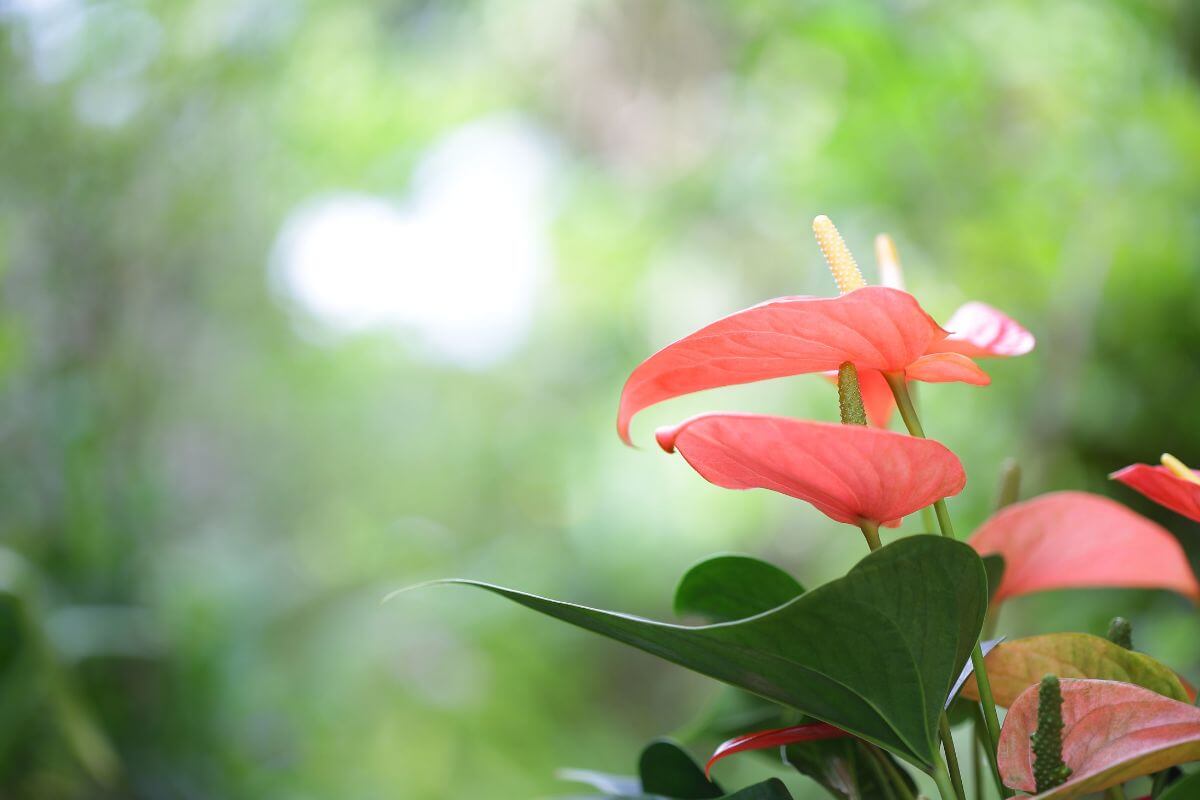
There are over 1000 anthurium species. Some of the more popular ones are:
- Queen Anthurium (Anthurium warocqueanum) – This species features long, velvety leaves with striking veins and can grow up to six feet long. It’s prized for its dramatic appearance and rarity.
- King Anthurium (Anthurium veitchii) – This variety boasts glossy, ribbed leaves that reach impressive sizes. Its elegant foliage makes it popular among plant enthusiasts.
- Velvet Cardboard Anthurium (Anthurium clarinervium) – Appreciated for its heart-shaped leaves with prominent white veining, this species is valued for its unique leaf structure and aesthetic appeal.
- Crystal Anthurium (Anthurium crystallinum) – Renowned for its beautiful, heart-shaped leaves, this variety is favored for its attractive foliage and ease of availability.
- Anthurium (Anthurium magnificum) – Features velvety, dark green leaves with unique squarish petioles. Its captivating appearance makes it a popular choice in the anthurium community.
- Regal Anthurium (Anthurium regale) – Known for its symmetrical, silver-veined leaves, the regal anthurium is highly sought after despite its challenging care requirements. It can grow quite large, making it an impressive addition to any collection.
- Flamingo Flower (Anthurium scherzerianum) – Often called the Flamingo Flower, this compact species produces bright red, long-lasting flowers with a unique curling spadix. It’s popular for its vibrant blooms and manageable size.
- Anthurium villenaorum – Features large, cordate leaves with prominent white veining. It is easier to grow compared to other velvet-leaved varieties, making it a good choice for beginners.
- Strap-Leaved Anthurium (Anthurium wendlingeri) – Characterized by its unique leaf shape, this variety is appreciated for its ornamental value. It thrives in bright, indirect light and adds a distinctive touch to any collection.
- Anthurium Silver Blush Mint – A newer variety with a frosted appearance and a glistening effect in sunlight. Its unique coloration has quickly made it a favorite among collectors.
What Are the Main Benefits of the Anthurium?
Anthuriums are not just pretty to look at, they bring a bunch of benefits to our indoor spaces. Here’s why you might want to add them to your home:
- Clean Air – These plants are like natural air filters. They tackle nasty stuff like ammonia and formaldehyde, making the air we breathe better.
- More Oxygen – Thanks to photosynthesis, they pump up the oxygen levels, which can give your energy and brainpower a nice boost.
- Moisture Balance – If dry air is a problem, Anthuriums help out by releasing moisture into the air.
- Stress Buster – Having these plants around creates a peaceful vibe, helping to lower stress and lift your mood.
- Stylish Touch – With their bright flowers and shiny leaves, Anthuriums add a touch of class to any room.
- Quieter Spaces – They also help keep things quiet by absorbing sound.
Adding Anthuriums to your indoor spaces is a win-win. They clean the air, boost your mood, and look great while doing it.
Anthurium Care Guidelines
Caring for Anthuriums? Keep an eye on these key points: soil, temperature, humidity, water, and fertilizer. Nail these down, and your Anthuriums will flourish in no time.
Anthurium Soil Requirements
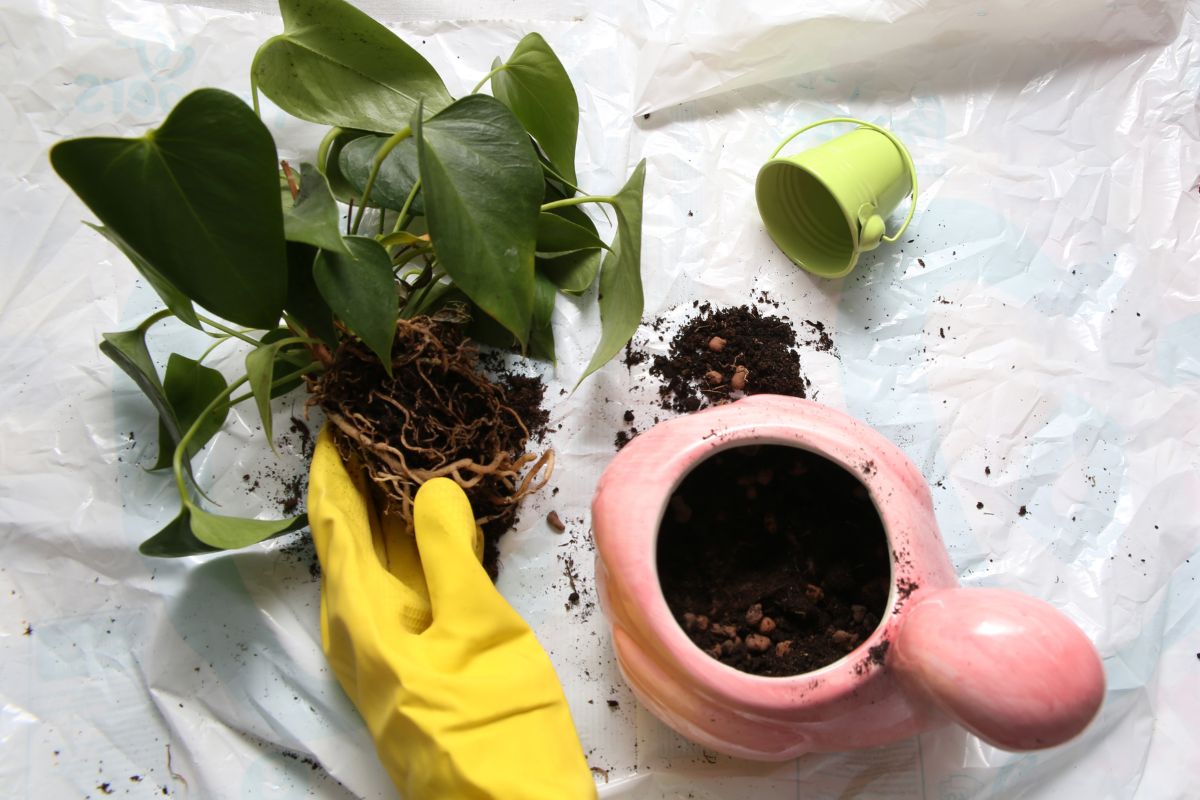
Since anthuriums don’t grow in the ground or soil. If you want to reproduce their natural growth environment, you can make your potting mix by combining one part pine or fir bark, one part peat moss, and one part pearlite.
If you choose to purchase potting soil, combine five parts of low-moisture potting soil, two parts peat moss, two parts orchid potting mix, and one part perlite.
They prefer a well-draining soil bed that is moist, but not wet. Another option is a well-draining potting soil for orchids, combined with a couple of handfuls of sand, and another couple of peat moss.
In nature, the anthurium “leans” on its host for support. If your plant can’t manage to stay vertical by itself, give it a trellis or stake for support.
Anthurium Temperature Requirements
Anthuriums love warmth, and each type has its sweet spot when it comes to temperature. For most, like the Anthurium ‘Ace of Spades’, they do best when it’s between 60°F and 90°F (15°C to 32°C). They thrive with daytime temps around 70°F to 85°F (21°C to 29°C) and prefer it a bit cooler at night, between 70°F and 75°F (21°C to 24°C).
If it gets hotter than 90°F (32°C), it can get stressed out and even damaged. On the flip side, if it drops below 50°F (10°C), their growth might slow down, and you might see their leaves turning yellow.
Anthurium Light Requirements
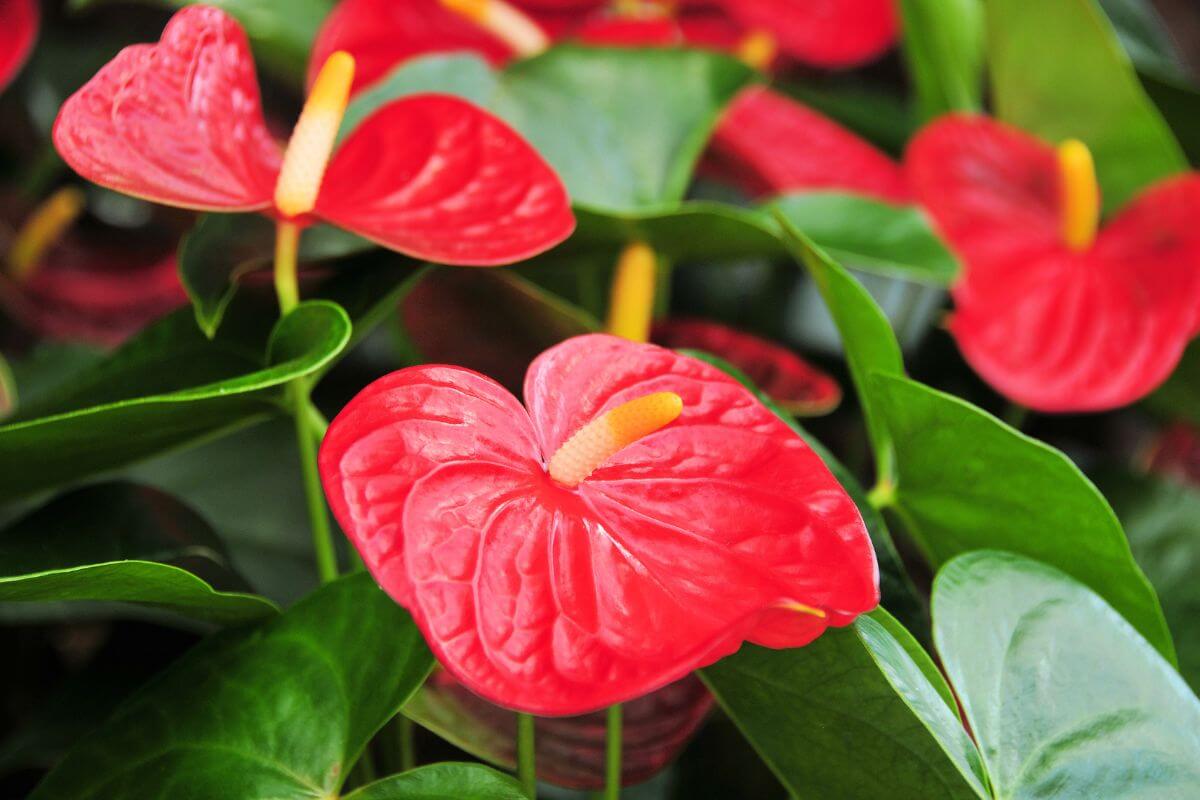
Anthuriums do best when they get bright, filtered light. This is like the spot they love in nature, under tree canopies, where the sunlight is dappled. They need about 500-1000 footcandles of light to grow well. But, for them to bloom beautifully, they should have more than 1500 footcandles.
You should aim for them to have 10-12 hours of light each day. This can be from the sun or from grow lights. If you put your Anthuriums near south or west-facing windows, they’ll get the bright light they need. Just remember to use sheer curtains. This way, the light is filtered, and the leaves won’t get scorched by too much direct sunlight.
They can handle a bit of direct sunlight, especially in the morning or late afternoon. But too much sun for too long can hurt them. If they’re in a place that doesn’t have enough light, LED grow lights are a great backup. Keep the lights about 12 inches away and make sure they cover the full spectrum to copy natural sunlight.
If your Anthuriums aren’t getting enough light, you might notice. The leaves can start to yellow or burn. This is a sign of inadequate light. So, make sure they’re getting what they need to stay healthy and vibrant.
Anthurium Water and Humidity Requirements
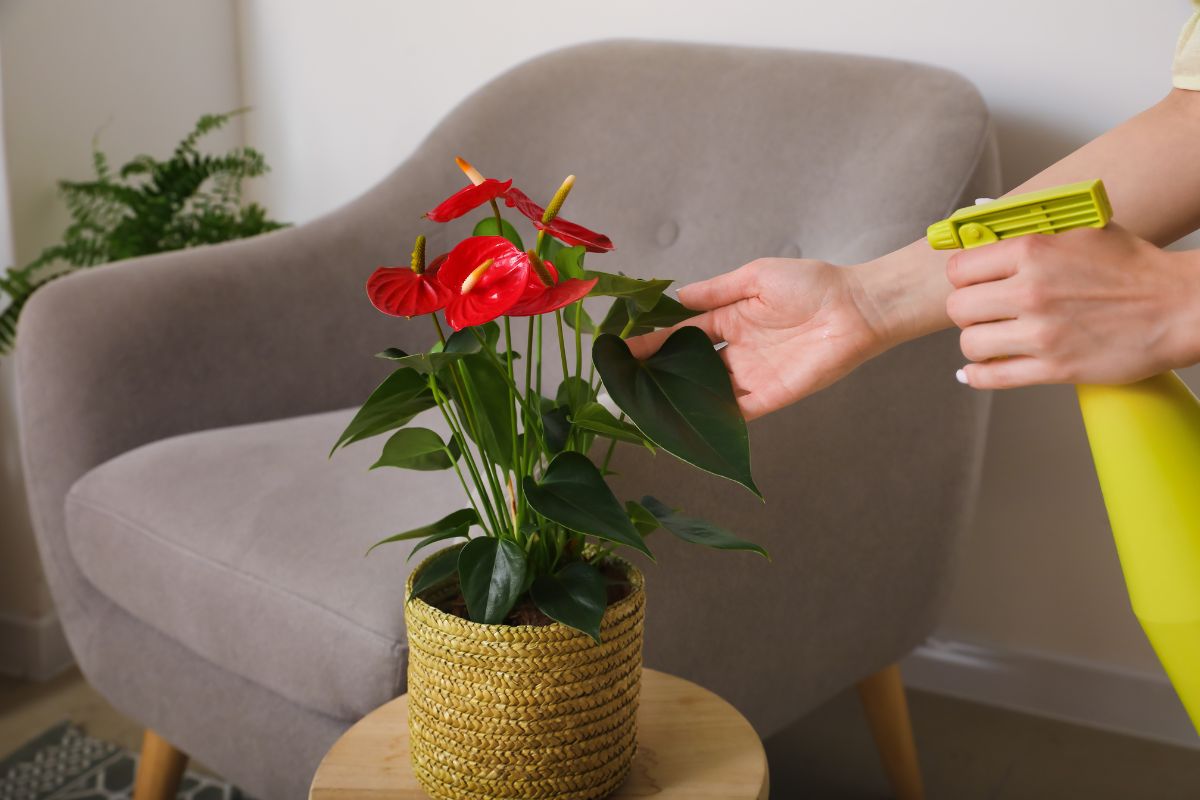
Anthuriums thrive in humid environments. If you don’t use a humidifier in the area of your plant, you can treat it to a misting occasionally. These plants like humidity levels between 50% and 70%, which means they prefer a humid room.
- Read more: Top Humidifiers for Plants
Do not place anthuriums near an air conditioner vent, a drafty doorway, or a drafty window. Bursts of dry or cool air can stress your plant and as a result, it will not grow or bloom well.
Anthuriums also don’t like sitting in water or having soggy soil for too long. Doing this leads to waterlogged roots and root rot, which is a plant’s worst nightmare.
The trick is to keep the soil moist but not drenched. A handy tool for this is a soil moisture meter, but you can also just stick your finger into the topsoil. If it feels dry a couple of inches down, it’s time to water. This way, you’re giving your plants the perfect balance of moisture without overdoing it.
During the warm spring and summer months, it’s best to water your anthurium once a week. In the winter, when the plant is dormant, watering every two to four weeks is sufficient. The exact timing can vary based on your climate. It’s important to keep the soil slightly damp, especially during hot weather.
The right way to water your anthurium is to do so until water seeps out from the drainage holes at the bottom of the pot. After watering, let it drain completely before placing it back in its spot.
You can use filtered, mineral, or distilled water. If you’re using tap water, it’s a good idea to filter it first. Tap water often has chlorine or fluoride, which can be harmful to the plant.
Anthurium Fertilizer Requirements
To make your Anthuriums bloom beautifully, you need a fertilizer high in phosphorus. Look for ones with ratios like 4-15-12 or 20-7-20. These help the flowers grow and keep the plant healthy.
Liquid fertilizers are a favorite for Anthuriums. You mix them with water at a weak strength, usually between a quarter and half of what the label says. This way, you avoid hurting the plant. Granular fertilizers work too, especially the slow-release kind. They give nutrients over time.
When spring and summer come, it’s time for growth. You can feed your Anthuriums with liquid fertilizer every month. If you choose slow-release ones, you might only need to do it once or twice. Just remember to mix the liquid fertilizer weakly to keep the roots safe.
If you notice the leaves turning yellow, it might mean they need more food or a different kind of fertilizer. And if you give too much fertilizer, don’t worry. Just wash the soil with water to get rid of the extra nutrients. This helps stop any damage to the roots.
How Do You Prune and Repot Anthuriums?
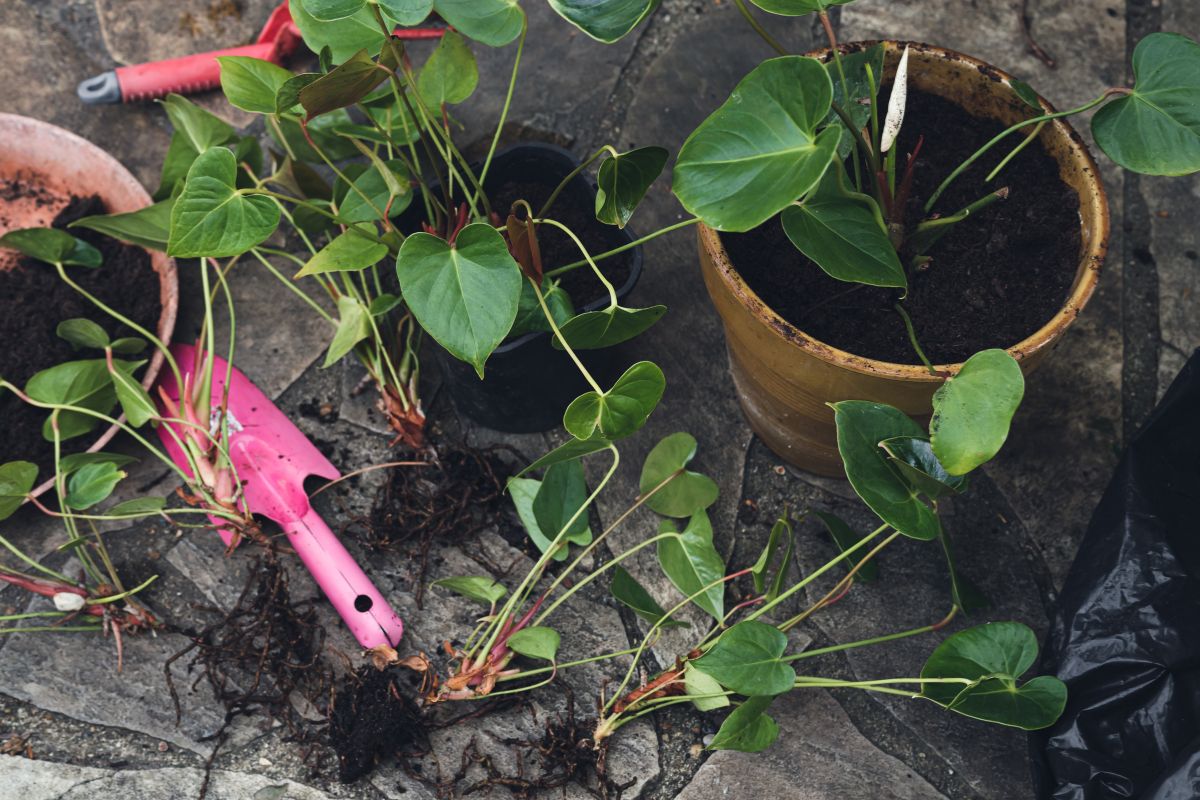
Caring for Anthuriums is pretty straightforward, and one of the best parts is that they don’t need a lot of pruning. If you spot any yellow leaves or old flowers, just grab some sharp scissors and cut them off close to the stem’s base.
Now, about repotting. The best time to do this is at the start of the growing season. But if your Anthurium looks like it’s outgrowing its pot—maybe you see roots on top of the soil or coming out of the drainage holes—it’s time for a new pot, no matter the season. A pot that’s cracked or leaves that are drooping can also be signs it’s repotting time.
When you’re ready to repot, you’ll need a new pot that’s a bit bigger —1 to 2 inches wider across. Make sure it has good drainage. For the soil, go for something light and airy. A mix made for orchids works great, or you can mix half orchid mix with half peat or coconut fiber.
Here’s how to repot your Anthurium:
- Put a piece of mesh or a coffee filter over the hole at the bottom of the new pot to keep the soil in.
- Water your plant a few hours before you start. This helps the roots stay healthy and makes the move easier.
- Turn the pot upside down, holding the plant’s base. Give the pot a tap to help loosen the roots. If it’s stuck, you might need to carefully cut around the edges.
- Once it’s out, check the roots. Trim off any that are dead or rotten with clean scissors. If the roots are all tangled, gently pull them apart.
- Add some fresh soil to the bottom of the new pot. Place your Anthurium in so the top of the roots is about an inch from the top of the pot. This setup helps to avoid overwatering.
- Fill in around the roots with soil, pressing it down lightly to get rid of any air pockets. Make sure the plant sits at the same level as it did in the old pot.
- Give it a light watering to settle the soil. If you need to, add more soil to keep the level right.
- After repotting, keep your Anthurium in a shady spot for a few days. This helps it get used to its new home. And hold off on fertilizing for a couple of months to give it time to settle in.
With these steps, your Anthurium should thrive in its new pot and continue to brighten your space with its beautiful blooms.
How to Propagate the Anthurium
To propagate an Anthurium, you can use several methods, including stem cuttings, root division, or seeds.
Propagating Anthurium Through Stem Cuttings
Propagating Anthurium through stem cuttings is one of the most effective and straightforward methods.
Materials Needed:
- Healthy Anthurium plant
- Pruning shears or a sharp knife
- Rooting hormone (optional)
- Well-draining potting mix or propagation medium (e.g., perlite, peat moss)
- Small pots or containers
Steps:
- Choose a vigorous plant with lush, green foliage and preferably one that is actively flowering.
- Cut a 6-10 inch section of stem from the mother plant just below a node (where leaves emerge).
- Remove the lower leaves to expose the nodes. Optionally, dip the cut end in rooting hormone.
- Place the cutting in a pot with well-draining potting mix or directly in water. Keep the soil lightly moist or change the water regularly.
- Place in bright, indirect sunlight and maintain humidity around the cuttings.
- In 4-8 weeks, check for new growth or roots. Once roots are several inches long, transplant into a larger pot with nutrient-rich soil.
Propagating Anthurium Through Root Division
Here’s a detailed guide on how to propagate Anthurium through root division:
Materials Needed:
- Healthy, mature Anthurium plant
- Clean, sharp knife or pruning shears
- Fresh potting mix
- New pots with drainage holes
Steps:
- Water the Anthurium thoroughly a day before dividing to ensure the roots are well-hydrated and easier to handle.
- Gently take the plant out of its pot and loosen the soil around the roots to expose them.
- Look for natural separation points in the roots, usually where multiple stems emerge.
- Use your hands or a sharp knife to separate the plant into sections, each with a healthy stem and a good portion of the roots.
- Remove any damaged or rotting roots with clean pruning shears.
- Fill new pots with a well-draining mix suitable for Anthuriums, such as peat moss, perlite, and orchid bark.
- Place each section in its pot, ensuring the roots are well-covered and the plant is at the same depth as before.
- Water thoroughly and place the pots in a warm, humid area with bright, indirect light.
Propagating Anthurium From Seeds
Here’s a guide to propagating Anthurium plants from seeds:
Materials Needed:
- Fresh Anthurium seeds
- Vermiculite or well-draining potting mix
- Shallow pots or seed trays with drainage holes
- Plastic wrap or humidity dome
- Spray bottle for misting
Steps:
- Collect seeds from a mature Anthurium flower or purchase them from a reputable source for the highest germination rate.
- Fill shallow pots or seed trays with moistened vermiculite or a well-draining potting mix. Ensure the medium is damp but not waterlogged.
- Scatter the seeds evenly on the surface of the medium and gently press them in without covering, as Anthurium seeds need light to germinate.
- Cover the containers with plastic wrap or a humidity dome to maintain high humidity. If using plastic wrap, poke a few small holes for air circulation.
- Place the containers in a warm area (70-80°F or 21-27°C) with bright, indirect light. Avoid direct sunlight, which can be too harsh for seedlings.
- Keep the medium consistently moist but not waterlogged. Mist the surface with a spray bottle as needed.
- Germination typically takes 14-28 days but can vary. Be patient and maintain consistent conditions.
- Once seedlings emerge, provide warm, humid conditions and bright, indirect light. Gradually reduce humidity by opening the cover slightly to acclimate the seedlings.
- When seedlings have a few true leaves and are large enough to handle, usually after several months, carefully transplant them into individual pots.
How to Grow Anthurium in Water
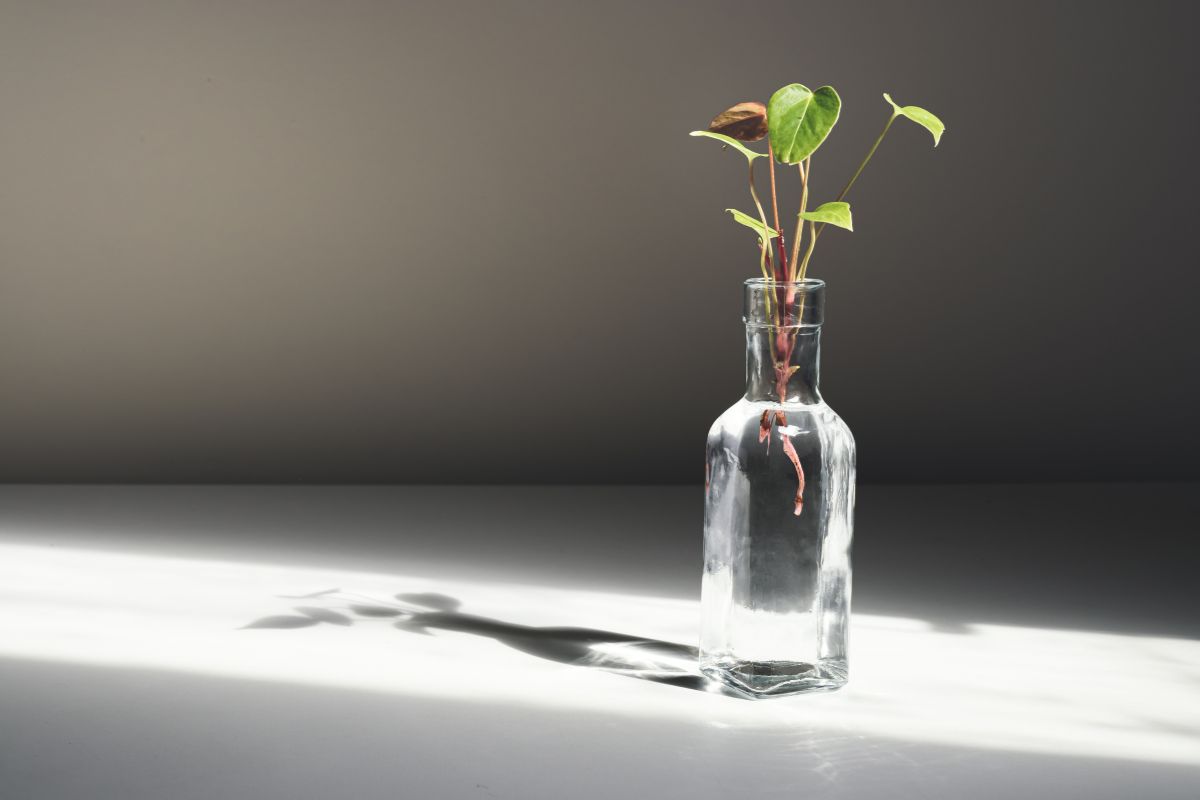
One nice thing about this plant is that you can cultivate it in water as opposed to soil. You will need:
- A vase or any large container
- Mineral water
- Plant fertilizer for indoor plants
To grow the anthurium in water, you’ll first need to transplant an anthurium plant from soil to water. Here’s how you do it.
- Choose a Suitable Container – Use a clear glass vase or container large enough for the Anthurium’s roots, allowing you to monitor growth rate and water clarity.
- Prepare the Plant – Remove the Anthurium from soil and rinse the roots gently with lukewarm water. Use a soft-bristled toothbrush if needed to remove stubborn dirt.
- Fill the Container with Water – Use room temperature, dechlorinated water (filtered or mineral water is best). Ensure the water covers the roots but not the stem to prevent rot. Avoid tap water with high chlorine or minerals.
- Placement – Place the container in bright, indirect sunlight. Avoid direct sunlight to prevent leaf scorch. Maintain a temperature between 65°F and 85°F (18°C and 29°C).
- Water Maintenance – Change the water weekly or when it becomes cloudy or unpleasant. Add a few drops of hydrogen peroxide to keep the water fresh and oxygenated.
- Fertilization – Feed the Anthurium once a month with diluted liquid fertilizer suitable for flowering plants to provide essential nutrients.
Replace or add water more often if you see that it needs more water or if you live in a drier climate.
Anthurium Plant Pests, Diseases, and Problems
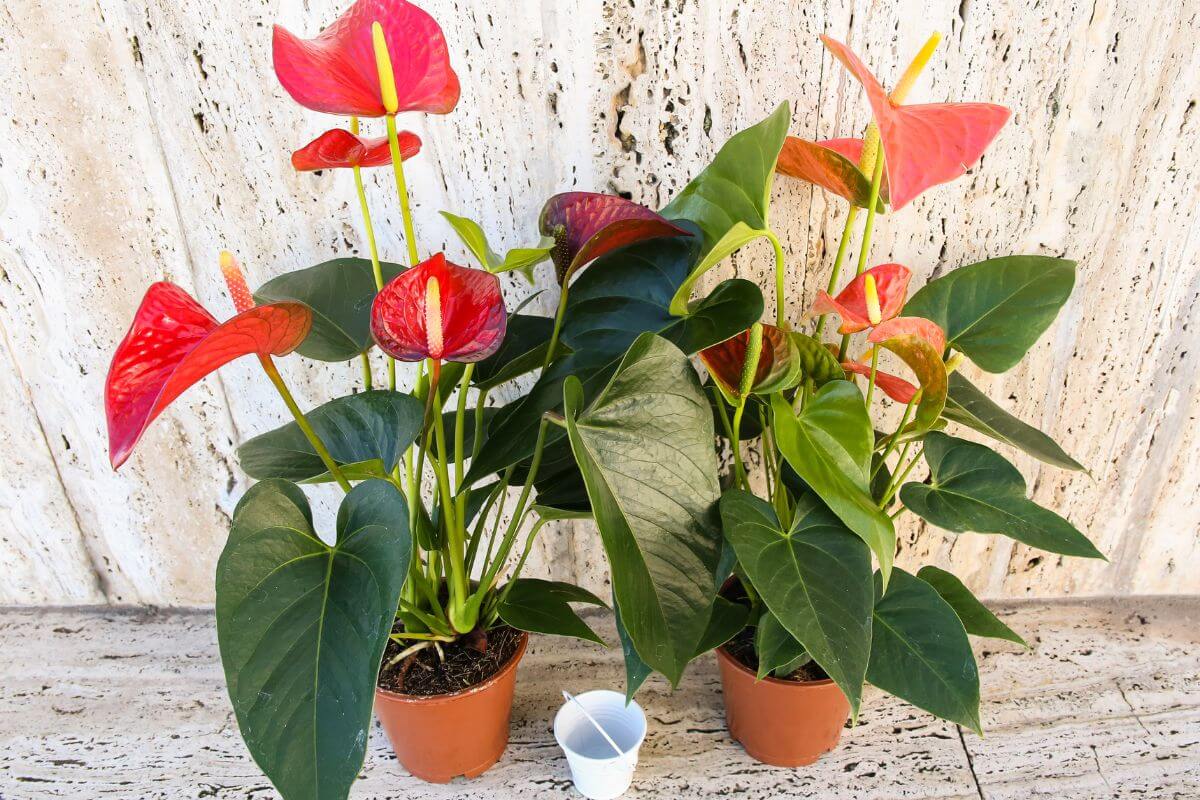
Anthuriums face threats from pests like aphids, scale, spider mites, whitefly, and mealybugs. Spotting these bugs or their signs means it’s time to act.
Here’s what you do: Wash the leaves with a mix of insecticidal soap and water. Just be careful not to get this on the roots.
Now, about those roots you see on the stems—those are aerial roots. You can mist them now and then or cut them off if you want. If you see roots coming out of the soil, your plant might be rootbound and needs a new pot.
Yellow leaves on your Anthurium? That could mean a few things:
- It’s getting too much direct sunlight
- It’s overwatered
- It’s underwatered
- It’s rootbound
Take a close look at your plant to find out what’s wrong and fix it.
Ideally, your Anthurium should bloom all year round. If it’s not flowering, something’s off with its care or surroundings. Try giving it a little feed and move it to a spot with more indirect light.
Are Anthuriums Toxic?
Anthuriums are toxic if ingested and will be a problem for both humans and pets. As with the other members of the Araceae family, it does contain calcium oxalate. Calcium oxalate takes the form of tiny crystals that are exceptionally sharp.
If Anthurium is chewed, ingested, or even handled, the crystals are released. That will cause irritation, pain, and in some cases severe inflammation.
For this reason, it would be wise to keep your Anthurium out of the reach of small children and pets.
Anthurium Plant Care Final Thoughts
Anthuriums really brighten up any space, whether it’s your home or office. Their lush leaves and bright colors are just stunning.
What I love about them is how easy they are to care for. They make any room look better and are perfect gifts for anyone who loves plants. Just a heads up, though: they’re not safe for kids and pets. So, it’s best to keep them out of reach to avoid any accidents.
Aside from that, having anthuriums around is just wonderful!
Anthurium Plant Care FAQs
1. Is Anthurium a Good Indoor Plant?
Yes, anthuriums thrive indoors with minimal care, enjoying bright, indirect light and enhancing air quality.
2. How Long Do Anthurium Plants Live?
Anthuriums can live 3–5 years before needing re-potting, offering several years of enjoyment.
3. How Poisonous Is Anthurium?
Anthuriums contain calcium oxalate, which can cause stomach ache, nausea, vomiting, diarrhea, and skin rashes if ingested. Rare cases can be severe.
4. Does Anthurium Purify Air?
Anthuriums help purify air by absorbing toxins, making them suitable for home and office environments.
5. Do Anthuriums Need Sunlight?
Anthuriums prefer bright, indirect sunlight and should be kept away from direct sun and heaters.
6. Can I Fertilize My Anthurium?
Fertilizing is optional but can promote larger flowers and better health. Avoid overfeeding.
7. Is an Anthurium an Annual or Perennial?
Anthuriums are perennials, returning year after year, unlike annuals that die off after one season.
For other houseplant guides to help you care for and grow indoor plants, check out these articles:







